One of the attractions of carnivorous plants is many species can be grown and enjoyed indoors. There is no better place for carnivores than in your living room. And your dining room. And your kitchen... Some species can be grown in a bright window but many require more light and possibly higher humidity than can be provided at a window. Artificial lighting can be used in combination with a terrarium, with commonly available shelving, or in any situation in your house where you would like additional lighting and plants.
This page is deprecated. It is here for historic reference.
Fluorescent lighting is an obsolete technology. Purchasing new fluorescent fixtures is not recommended.
Please see the page on LED lighting for more information on cooler, more efficient, and better spectrum LED lighting. This page still is a good reference on plant lighting in general and efficiently using any fluorescent fixtures you may have.
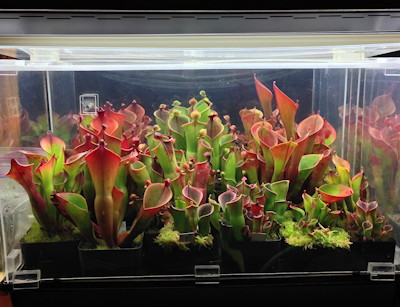
A 12 inch deep shelf as a growing area with a two-bulb, T5-HO fixture designed for plant lighting. The bulbs are 4000 K.
I now recommend only using LED lighting with Heliamphora. These plants could be kept cooler and started growing MUCH better after switching to LEDs.
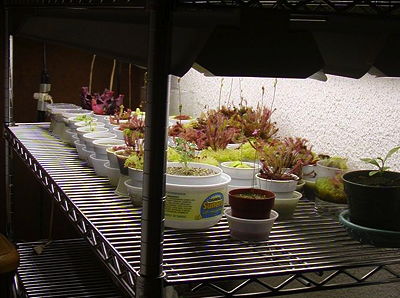
An 18 inch deep growing area with two two-bulb "shop light" fixtures. Photo by Forbes Conrad.
How much light do carnivorous plants need?
In their native habitats many carnivorous plants live with full exposure to the sun. This is about 100,000 lux of light at noon. To grow these plants indoors requires a lot of light, not 100,000 lux but still a lot. Even plants that normally live in somewhat shaded conditions still require more light than a lighting designer would suggest for indoor lighting for humans. Bright shade is about 15,000 lux; typical office lighting is 1000 lux. The table to the right lists the amount of light required by carnivorous plants commonly grown indoors under lights.
To get this amount of light to your plants with the lowest cost to yourself and the environment requires the use of 21st century lighting technologies. Fortunately for carnivorous plant growers there is another set of growers who are essentially indoor farmers. They have a set of specifications and protocols necessary to produce the best quality of their crop. With the large amount of electricity they consume there is an an incentive to either find or produce the most efficient lighting systems for growing plants indoors. Many indoor farming stores and web sites sell specialty lighting products that are vastly superior to the consumer grade lighting products available at big-box home stores. They also have protocol sheets on all aspects of growing their plants. Much of this information is useful for carnivorous plant growers.
To grow full sun carnivores such as Heliamphora and Sarracenia requires about 25,000 lux of light for 12 to 16 hours per day. You can achieve this by providing 2400 lumens per square foot of growing area or using 25 watts of T8, T5, or T5-HO fluorescent lighting per square foot of growing area or 40 watts of compact fluorescent lighting per square foot of growing area. By "growing area" I do not mean just the area directly under the lamps. I mean the total area illuminated by the lamps. The farther away the lamps are from the plants the larger the growing area irrespective of where you actually have the plants. Use of mirrors or other highly reflective surfaces will eliminate lumen loss caused by light exiting beyond where you want to grow the plants. With a mirror on one side of the growing area this translates into the bulbs being about 5 inches (13 cm) above the tops of the plants. If you do not want to or cannot use mirrors or the lights are farther away from the plants you may need lamps that produce twice as many lumens. You can also grow species that require less light in the area not directly under the lamps since the light will be dimmer on the sides compared to immediately under the lamps.
Other carnivores such as Cephalotus, Dionaea, and most Drosera species would prefer 25,000 lux but do OK at 15,000 lux. There are Nepenthes species that live in full sun and can handle well over 15,000 lux but most will do OK even below 8,000 lux. Remember these numbers are for high CRI fluorescent lighting. The plants will need higher lux values under "wide spectrum" lighting that more closely matches the curve for human eye sensitivity.
A timer should be used to control the lights. A heavy duty electronic timer with battery backup will help assure the lights go on and off at the same time every day. If you are growing temperate plants you might want to get a timer that adjusts the on and off period to seasonal day length. If the timer is designed to be on all night and you want it on all day with the longest time on at the summer solstice, then set the time and date off by exactly 6 months and 12 hours. If the timer allows you to set an on event at sunrise and an off event at sunset then that is perfect.
What kind of light do carnivorous plants need?
We are using lux here to indicate the amount of light the plants need. The use of lux in this context is a little problematic and some might argue is wrong. A lux is a measure of how bright the lighting appears to humans. In the figures to the right you can see that colors of light that human eyes are sensitive to are exactly the colors of light that plants reflect. Plants absorb, and thus do not reflect, colors that are too blue and too red for us to see well. Plants need the blue and red light in order to survive and grow. They do not need the green light.
A lux meter will measure the light from fluorescent bulbs with the same sensitivity as the human eye. This is somewhat problematic since fluorescent bulbs emit a discontinuous spectrum. The plants will like the 440 nm blue and 620 nm orange peaks but those peaks will be discounted by the lux meter relative to the 550 nm green peak the plants could care less about. There are so-called PAR (photosynthetic active radiation) meters that use a wider color response curve. They are better but not perfect partly because they do not discount the green light. Also note that companies that sell PAR meters use a different photosynthetic response curve. There is a lot we do not know about the light needs of plants.
There are or were fluorescent bulbs sold as plant lights. GRO-LUX® bulbs are dim (to humans) and the plants look purple from all the blue and red light. Helson (1965) did a study comparing the growth of tomatoes under GRO-LUX® and cool-white fluorescent lights. It did not matter which fluorescent bulbs were used. This was surprising because a large percentage of the light from the Halo-technology cool-white bulbs available at that time is green light and should theoretically not be useful to the plants. Light from the GRO-LUX® bulbs is supposed to be much closer to what the plants need. What was even more surprising is the addition of incandescent lights greatly increased growth and fruiting of the tomato plants. It was proposed the advantage of the incandescent lights was a result of the high amount of red light given off by incandescent lights.
Sylvania GRO-LUX® Wide Spectrum Spectral Power
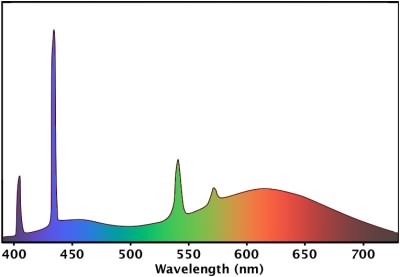
GRO-LUX® Wide Spectrum bulbs appear to be dim because a large fraction of the light they emit is at wavelengths to which humans have a low sensitivity. This spectrum is from GRO-LUX® T-12 bulbs using old halophosphate-type phosphors. Unfortunately older T12 bulbs are not very energy efficient.
Sylvania GRO-LUX® Spectral Power
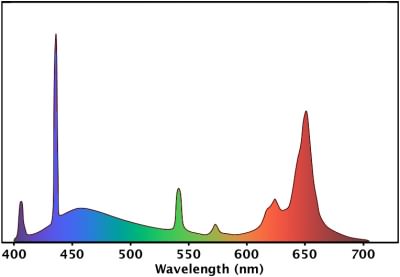
This GRO-LUX® bulb uses a slightly different mix of phosphors than the wide-spectrum bulb punching out more power at 660 nm, the peak absorption wavelength of chlorophyll. Your plants may like the light from this bulb but the plants will look purple. These bulbs are only available in T12 if you can get them at all.
Helson's results do not mean we should be using incandescent lights along with fluorescents. Incandescent lights require 4 to 5 times the amount of electricity to produce the same amount of light as produced by fluorescent lights. Plus the experiments were done in temperature controlled growth chambers. Incandescent lights give off too much heat to be used close to plants.
With new LED lighting technology it is possible to create lamps that are tuned just for plants. LED lights are very energy efficient and could be what we use in the future for all indoor lighting. If the study by Helson can be duplicated with LEDs at different wavelengths then we can answer some of the interesting questions raised by the Helson study. One question is if the better growth was the result of red light (which the GRO-LUX® bulbs produced more of but did not help), what wavelength of red light was responsible? If it turns out that all that matters is light at the 660 nm chlorophyll absorption peak, then that would mean the new combination fixtures with T5-HO fluorescents and 660 nm red LEDs are worth considering. Right now those lights are very expensive to buy and it may be more cost effective to use fixtures with more fluorescent bulbs.
All this discussion of light the plants want begs the question of who are you growing your plants for? Yes you want your plants to be happy and grow nicely, but are you growing the plants because we need more carnivorous plants on this planet or do you grow them because you want to enjoy them? To enjoy plants in their natural colors we have to stick with lights designed for human eyes. If it means we have to give them more light we can see so they get enough of the light they can use, so be it.
Which lighting technology is the best?
There are a number of fluorescent lighting technologies available. T12 fluorescents have been around for a long time. You can upgrade old magnetic ballasts to electronic ballasts and get bulbs with newer phosphors but this technology is not very efficient for plant lighting. Some time ago T8 fluorescents replaced T12 as the standard lighting technology for human habitats and T8 is still used in new applications. However T8 is not the best for plant lighting.
The technology that gives the most light at the lowest cost is T5-HO. There are three kinds of T5 fluorescent lamps. Each requires a different kind of electronic ballast and bulb. You must match the T5 bulb with the ballast in the lighting fixture to get the expected results. Standard T5 is essentially the new T8. Both are adequate for home and office lighting but relatively dim for plant lighting unless you use twice as many bulbs. However T5-HO and T5-VHO are what indoor farmers use and for good reasons. I will ignore T5-VHO here because it is hard to find T5-VHO fixtures and bulbs and they can be overkill for CP use. Again, when you buy a fixture and bulbs you must pay attention.
There are multiple advantages to T5-HO lamps. You only need half as many bulbs because they are almost twice as bright as T8 and regular T5 bulbs. With fewer bulbs the fixtures can be narrower allowing better air circulation to keep the plants under the lamps cooler. T5-HO bulbs cost only a little more than high quality T5 and T8 bulbs so you save money buying fewer bulbs. Fewer bulbs also mean less mercury to recycle. T5-format bulbs allow fixtures to be more efficient. T5 and T5-HO bulbs are thinner than T8 bulbs. This allows the reflectors in the fixtures to better reflect the light from the back of the bulb around it to the plants.
What features of lighting fixtures are important?
You will be spending about US$20 per square foot of growing area per year for electricity (assuming 12¢/KWH) so it is worth a little money getting a fixture that gets as much of the light as possible to the plants. It is also important to get fixtures that are well made and sturdy. You are not mounting this fixture to a ceiling or out-of-way place. It will get banged around.
As far as your plants are concerned, the most critical feature for a fixture is the reflector. The plants will only be able to directly see half of the bulb. A good reflector is needed to redirect the light from the back of the bulb to the front of the fixture. Look for fixtures with a mirror-like reflector where you can clearly see the back of the bulb. If you can see it your plants can too.
Look for fixtures at indoor farming stores. Unlike the fixtures in home stores, the fixtures at indoor farming stores are intended for heavy use. When a fixture there has a 5-year warranty they know you intend to use it at least 25,000 hours in that time so it includes better quality parts. Chances are the owners of the fixture manufacturer build the fixtures they want and need for their own indoor farms and the store owners use the equipment they sell for the same reason. Do the executives of the large national home stores eat their own dog food?
What kind of bulbs are best?
As far as bulbs, there is no "best". There are just a lot of trade-offs. But the short answer is choose the brightest bulbs with the highest color rendering index (CRI) of whatever color temperature you and your plants seem to like.
The reason for using the brightest bulbs is most manufacturers produce bulbs of different quality for different markets. In general the brighter bulbs use their newer formula phosphors and coatings. That is also the reason for getting the highest CRI bulbs. The selection and qualities of the phosphors in highest CRI bulbs provide higher light emission in the blue and orange part of the spectrum. This is good for your plants and they will look better to you as well.
The part that is most confusing is which color temperature to use. In some ways it does not matter. All of the bulbs of the highest CRI use the same phosphors, just in different ratios. An argument could be made that a combination of the highest and lowest color temperature bulbs will give the highest emission in the blues and reds. This might be true. But the issue is more complicated.
If you walk into an indoor farming store and ask for new T5-HO bulbs they will want to know whether you want "grow bulbs" or "bloom bulbs". Because many indoor farmers are not in the least interested in botany or the plants themselves, they only want the crop, there are protocols for the whole process from seed to weed for the horticulturally challenged. One part of that protocol is to start out with 6500 K bulbs. Their plants growing under 6500 K "grow" lights grow tall and branch profusely (so I am told). When it is time to mature the plants they switch to 3000 K "bloom" bulbs. Under "bloom" bulbs the plants stop growing taller, bulk up, and bloom (again, so I am told). For carnivores you want something in between.
Personally I dislike 6500 K light and to me, my plants under that light look as if they are not getting enough light, whether or not they really are getting enough. I do like how my plants grow and look under 3000 K light. They are shorter and redder. However if I move a plant from 3000 K light to 4000 K light the green part of the leaves look a little pale at first then get darker green after a few weeks. I have now switched to 4000 K T5-HO bulbs as I replace the 6500 K/ 3000 K combination bulbs. If your only source for good quality bulbs is an indoor farming store you are probably best off with a combination of both 6500 K and 3000 K bulbs. If you have a source of good quality 4000 K bulbs, you and your plants might like them best.
How often should I replace my bulbs?
The decision of when to replace bulbs is based on how much you are paying to run your lamps and how much of a light boost your plants would get by using new bulbs. The light output from fluorescent bulbs decreases over time. For T5-HO and the newest high CRI T5 and T8 bulbs the light output decreases to about 95% of the original value in the first six months of use. The light output then decreases very slowly until the bulb begins to fail. The inexpensive consumer grade T5-HO, lower CRI T5 and T8, and newer higher CRI T12 bulbs lose intensity quicker and do not begin to level off until about 90% of the original value. This happens when the bulbs have been in use a year. CFL bulbs have horrid lumen maintenance.
To do the math, you will be spending about $36 per year for electricity to run one 54 watt T5-HO bulb. It will cost about $10 to replace the bulb and recover about $1 to $2 worth of light depending on the expected lumen loss for the specific bulbs you have. If the bulb shows any indication it is failing, such as being dimmer than other bulbs the same age or getting very dark on the ends or showing spots on the inside coating, replace it as soon as possible. Otherwise I would replace the bulb at 60% of their rated life. At this point the manufacturers say 10% of the bulbs should have failed and you are just getting into the steep part of the failure curve.
For a CFL bulb it is a different story. You can do the electricity math but after a year of use the bulb is ready to fail and either your plants had more light than they needed when you started using the bulbs or they are suffering from lack of light now. This is an unfortunate issue with CFL's because they are easy to use in otherwise difficult locations. Plan on replacing them often.
-- John Brittnacher
August 2013
For more information please see:
Helson, V.A. (1965) Comparison of GRO-LUX and cool-white fluorescent lamps with and without incandescent as light sources used in plant growth rooms for growth and development of tomato plants. Canadian Journal of Plant Science 45(5):461-466.
The information in the tables and figures is based on Osram Sylvania documents unless otherwise specified:
Sylvania Technical Information Bulletin. (2000) Light and Plants: Standard and Wide Spectrum SYLVANIA GRO-LUX® Fluorescent Lamps.
Sylvania Product Information Bulletin. (2001) GRO-LUX® Aquarium and Aquarium Wide Spectrum Fluorescent Lamps for indoor gardening.
Sylvania. (2011) Product Safety Data Sheet, PSDS No. 1.1.8, T5 Fluorescent Lamps.
Sylvania. (2012) OCTRON® 700 ECOLOGIC® Fluorescent Lamps.
Sylvania. (2013) PENTRON® HO ECOLOGIC® High Output T5 Linear Fluorescent Lamps.
Sylvania. (2012) SAFELINE® Shatter-Resistant Coated Fluorescent Lamps.
Measure of light intensity given off by a lamp or other light source as perceived by humans. (Wikipedia)
Lux (lx)
Measure of light per surface area as perceived by humans. 1 lux is equal to 1 lumen per square meter. (Wikipedia)
Color Spectrum
A graph of the colors we see at different wavelengths.
Spectral Power
The intensity of light radiated from a source at different wavelengths.
Color Temperature
The apparent color of light of mixed wavelengths expressed in Kelvins (K) (Wikipedia). Light over 5000 K can appear cool or bluish; light under would appear warm or redish. Never mind "cool" light has a higher color temperature than "warm" light.
Color Rendering Index (CRI)
A measure of whether objects under a given lamp will appear the same color as they would under natural light. (Wikipedia)
Fluorescent lamp
Read about how fluorescent lights work at Wikipedia.
| T12 | - | Old technology fat tubes, do not use it. | |
| T8 | - | Current standard for office lighting. | |
| T5 | - | Possible future standard for office lighting. Uses less mercury and strategic material per bulb than T8 and T12. | |
| T5-HO | - | High output version of T5. Excellent for plant lighting. | |
| T5-VHO | - | Specialty, very high output lighting. | |
| CFL | - | Replacement for incandescent lighting. Can be used for plant lighting but not very efficient. |
Ballast
Ballasts in fluorescent light fixtures act to limit the current to a bulb. Old magnetic ballasts are obsolete and any fixtures with a magnetic ballast should be replaced with a fixture using an electronic ballast. Electronic ballast efficiently start fluorescent bulbs and drive them with high frequency pulses of electricity. (Wikipedia)
LED Lighting
Uses high power light emitting diodes to produce light more efficiently than fluorescent lighting. (Wikipedia)
High Intensity Discharge (HID) Lighting
High intensity discharge plant lighting comes in two flavors: high pressure sodium and metal halide. This technology is commonly used for street lights with the sodium lights being orange and the metal halide lights being green. This kind of lighting is useful for supplemental lighting in greenhouses but not really appropriate for growing carnivores indoors. (Wikipedia)
Lighting requirements for carnivorous plants commonly grown under lights. The plants will survive with less light but not grow as well.
| Genus/Species | Lighting Requirement |
| Cephalotus | intense light |
| Dionaea | intense light |
| Drosera (most species) | intense light |
| D. adelae D. prolifera |
moderate light |
| D. schizandra |
low light |
| Genlisea | moderate light |
| Heliamphora | intense light |
| Nepenthes | moderate light |
| Pinguicula | moderate or intense light |
| Sarracenia seedlings S. psittacina S. rosea |
intense light |
| Utricularia | moderate light |
|
intense light About 15,000
|
To get 25,000 lux requires 2400 lumens or 25 watts of T8, T5, or T5-HO fluorescent lighting per square foot (30 cm by 30 cm) of growing area or 40 watts of compact fluorescent lighting per square foot. The plants need the lights on for 12 to 16 hours per day. The lamps should be about 5 inches (13 cm) above the top of the plants with reflective material on three sides. At 10 inches (25 cm) from the lights, the intensity will be 15,000 lux. If the lights are farther away from the plants or light is exiting the growing area on all sides, more lighting is required. Inefficient lighting fixtures will also require the use of higher lumen bulbs. With lights this close to the plants, care must be taken to keep the plants from getting roasted by the heat generated by the bulbs. A layer of glass or Plexiglas between the bulbs and the plants will help. |
|
moderate light About 8,000 |
This lower light level can be achieved by using fewer or different bulbs or fixtures, illuminating a larger area, or not using side reflectors. You can use the lamps used for intense light plants except the lamps should be 10 inches (25 cm) above the plants. |
|
low light About 3,000 |
This is still more than human office lighting levels. Use indirect light or spillover from adjacent plant lighting or a low wattage compact fluorescent lamp. |
Human Eye Color Sensitivity
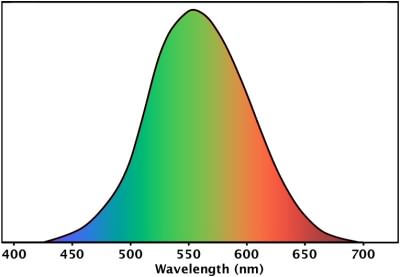
The human eye is most sensitive to green light. This is the relative spectral response used in determining lumens of a light source and thus how bright the light will appear in terms of lux. For a red light to appear as bright as a green light, the red light must emit more radiation than the green light because humans are not as sensitive to red light.
Chlorophyll Absorption
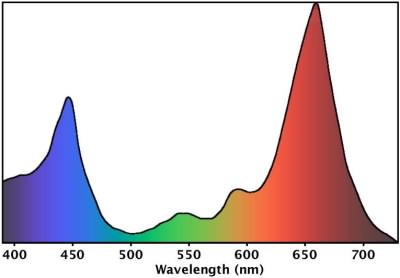
Relative spectral response of chlorophyll. Chlorophyll absorbs mainly blue and red light. Plants appear green because they reflect green light.
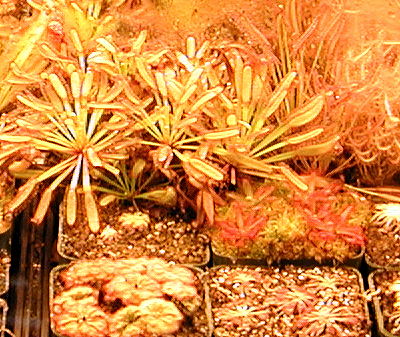
These plants may love the red light but do you?
Comparison of the efficiency of different fluorescent lighting technologies. The bulbs in these tables were chosen to compare technologies and may not be available at this time. Bulbs you can buy will have different ratings.
| Bulb | Watts | Initial lm | Mean lm |
Mean lm |
| CFL* | 26 | 1700 | 1365 | 53 |
| T12 | 40 | 3230 | 2907 | 73 |
| T8** | 32 | 2716 | 2444 | 76 |
| T8 | 32 | 2891 | 2746 | 86 |
| T5 | 28 | 2550 | 2372 | 85 |
| T5-HO | 54 | 4850 | 4510 | 84 |
Comparison of the yearly cost of different fluorescent lighting technologies. 10,000 lm is about the amount of light from a 48 inch, two bulb, T5-HO fixture.
| Bulb | CRI | 40%-life lm Loss |
60%-life in years |
Bulbs for ~10K lm |
10K lm |
| CFL* | 82 | 20% | 0.9 | 6 | $159 |
| T12 | 80 | 10% | 2.2 | 3 | $105 |
| T8** | 78 | 10% | 3.3 | 3.5 | $97 |
| T8 | 85 | 5% | 3.3 | 3.5 | $87 |
| T5 | 85 | 7% | 2.7 | 4 | $92 |
| T5-HO | 85 | 7% | 3.3 | 2 | $85 |
All bulbs are Sylvania Safeline 800 series, 48 inch linear, 4100 K except:
* GE spiral CFL
** Sylvania 700 Safeline 700 series
The lifetime rating of a bulb is the point where half of a batch of bulbs are expected by the manufacturer to have totally failed.
At 60% of the lifetime rating, about 10% of bulbs are expected to have failed and the mortality rate increases quickly after this point. This is a good point to replace bulbs. For T5 and T8 bulbs some people wait until the bulbs fail.
Manufacturers "mean lumens" is based on lumens at 40% of bulb life. Mean lumens was used to calculate the cost for 10,000 lumens per year replacing bulbs at the 60% lifetime rating.
Cost estimates are based on $0.12 per KW hour of electricity.
Data are from the Sylvania SAFELINE® Shatter-Resistant Coated Fluorescent Lamps catalog except for the CFL which is from the GE FLE26HT3/2/841 data sheet.
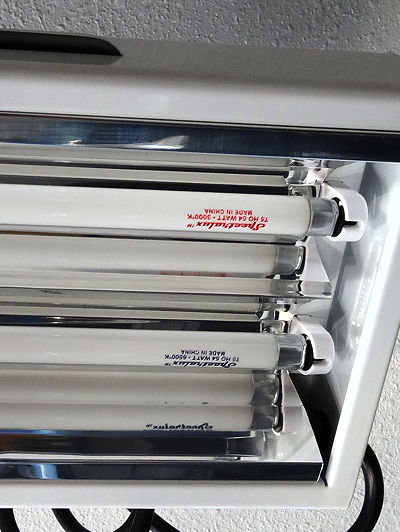 A very sturdy, well made, T5-HO fixture with an excellent reflector available at indoor farming stores. The fixture comes with two 6500 K bulbs. I swapped out one 6500 K for a 3000 K.
A very sturdy, well made, T5-HO fixture with an excellent reflector available at indoor farming stores. The fixture comes with two 6500 K bulbs. I swapped out one 6500 K for a 3000 K.
Spectral Power of a 6500 K T5-HO fluorescent bulb with a high color rendering index
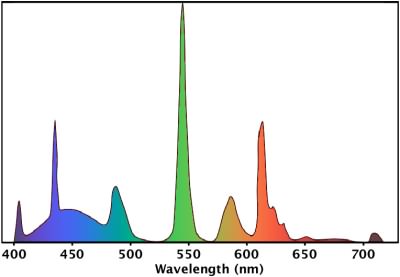
This is the spectrum from some of the best quality and most efficient T5-HO fluorescent bulbs for human use. Under these lights object appear the correct color and the lights are very bright. Most of the light is outside the preferred spectrum for plants.
Spectral Power of a 3000 K T5-HO fluorescent bulb with a high color rendering index
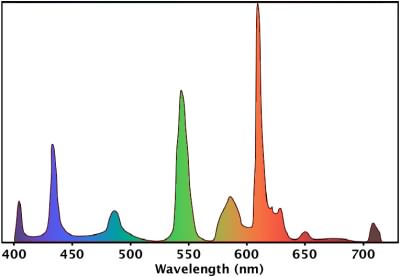
For the modern fluorescent bulbs the only difference between the different color temperature bulbs within a phosphor product series is the ratios of the phosphors causing the blue and orange peaks. This spectrum has the same color rendering index as the 6500 K bulb but overall the light is redder or warmer.
Lumen Maintenance of fluorescent bulbs
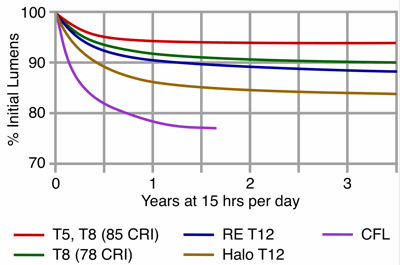
These are the lumen maintenance curves for the bulbs listed in the tables above except there is no pure Halo bulb listed above. The major cause of decreasing light intensity of fluorescent bulbs is the migration of mercury into the glass. Generally the newer technology bulbs maintain their light intensity better than the older technology bulbs by managing the mercury better. Check the manufacturers specifications carefully as some consumer grade high CRI bulbs have relatively low lumen maintenance.
There may be compact fluorescents lights (CFL) with better lumen maintenance curves.
| RE = | Rare Earth (T5,CFL, and most T8 bulbs also use rare earth phosphors) |
| Halo = | Halophosphate-type phosphors used in old T12 bulbs and some T8 bulbs. |
| From the Product Safety Data sheets it appears high CRI bulbs use a mix of RE and Halo phosphors. | |
Survival rate of a 20,000 hour rated fluorescent bulb
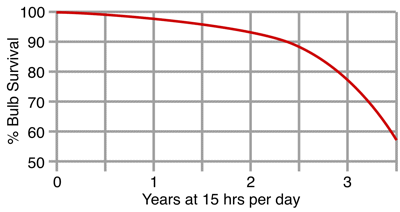
Typical bulb survival rate for a fluorescent bulb rated at 20,000 hours and used 15 hours a day. A bulb rated at 30,000 hours would cross the 50% survival line at 5.5 years. A bulb rated at 8000 hours would cross the line at 1.5 years.
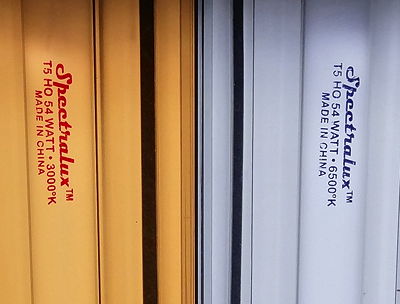
Direct comparison of the light from 3000 K and 6500 K bulbs.
